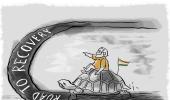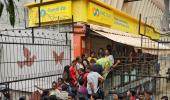'The government has failed to understand the seriousness of the situation, and that's why they are underestimating the problem.'
'They think some tinkering here and there will fix the economy automatically.'

Dr Surajit Das, assistant professor at the Centre for Economic Studies and Planning at JNU, told Shobha Warrier/Rediff.com in the first part of the interview that he expects the economy to grow at minus 20% this year.
"This is not the time for fiscal conservatism; this is the time to print money and boost the economy by larger government expenditure," Dr Das says in the concluding segment of a two-part interview:
The government came up with a Rs 20 lakh crore stimulus package which had no impact on the economy or excited investors...
The Aatmanirbhar Bharat package will not be able to stimulate the economy.
That's because the design of the programme is such that out of this Rs 20 lakh crores, 75% of the package is all about the RBI trying to infuse liquidity in the financial system or the government encouraging farmers and MSMEs to take loans without any collateral, and with government guarantees at a relatively lower interest rates.
And the rest of it is about free food grains supply, Rs 500 per family per month and MGNREGS jobs for the poorest of the poor.
However, no investor will make any investment, which is adding to the existing capital, right now because all the industries are suffering from unutilised capacity already. They will not invest more until there are profitable opportunities.]
It will happen only when there is demand, and when people have purchasing power.
That's why the Aatmanirbhar Bharat package will not work. It is based on the assumption that if there is liquidity infusion, there will be a take off.
But what can happen is all these MSMEs and farmers will take new loans on easier terms to pay off past loans.
And the investment or aggregate demand will not go up because of this. In fact, the credit-deposit ratio of the commercial banks is continuously falling since the last week of March.
Is the economy in recession or in depression?
If there is a contraction of -20%, what will you call it?
And this is not going to go away suddenly next year. Because of the vicious circle that we are in, if the growth is -20% this year, we may have to wait for another four to five years for normalcy to come back to the business as usual situation.
Five years? That's a long time...
I think so. If it is -20% this year, next year we will have positive growth compared to this year because the base will be much lower.
However, to reach the level of employment and output we were in before 2020-2021, we may have to wait for 4-5 years.
Not only for India but worldwide also, it will take time to recover. That is because most of the governments are doing only lip services like what we are doing in India.
Apart from giving some rice and dal and Rs 500, which many did not get as per our survey, the government did not do anything substantial yet.
I was arguing that all the economies in the world have to give a big demand side push in terms of fiscal stimulus for recovery.
What kind of push are you arguing about?
By demand side push, I mean the government expenditure has to rise substantially.
For example, our health expenditure is one of the lowest in the world at less than 1% of the GDP including both the central and state governments. This has to rise substantially.
Before 2000, the Chinese health expenditure was also like India's. But now, they have increased it gradually to 3% of GDP.
There should be universal employment of last resort programme in place and there should be some cash transfers to compensate for peoples' income loss due to the COVID-19 induced lockdown.
There is a lack of planning in our country, and we try to follow other countries quite blindly.
Yes, the government exchequer is an extremely tight situation right now. In the last financial year, the fiscal deficit of the central government alone has gone up by 2% of the GDP than what was expected in the Budget.
Because of the revenue shortfall, the government does not have much money and they are clueless on how to enhance expenditure. This is true for the state governments as well.
Is that not the reason why there was no public spending and they were talking about the PPP model?
 Now, the Union government is selling off all the public sector units to get some money.
Now, the Union government is selling off all the public sector units to get some money.
All the eminent economists are talking about not just public spending but direct cash transfer to people as they are indebted after the lockdown. And it shouldn't be Rs 500, but Rs 7,000 to Rs 8,000 per family per month.
As unemployment which is skyrocketing in the country, the MNERGA programme should be expanded to the urban areas too as 50 crore (500 million) people live in urban India.
Also, the 100 days a year cap on a family should be lifted till the employment situation becomes better.
The daily wage of MNERGA should go up at least to the minimum wage rate.
The out of the pocket expenditure on health is abysmally high in this country. If the government spends more on health, education etc, people will get some extra purchasing power in their hands, it will be helpful for boosting the aggregate demand.
This is the way to give a big push to the demand side of the economy for a recovery.
And this has to happen in a co-ordinated manner in all the countries. If you remember, after the 2008 financial crisis, there was a co-ordinated fiscal stimulus given all over the world. That kind of push is needed in the current situation.
The government is talking about green shoots starting in the rural areas...
It is a fact that the rural economy would suffer less compared to the urban economy as demand for agricultural produce will be there unlike demand for automobiles or tourism or other consumer durables.
But I don't think recovery is happening faster in the rural economy.
Until the fiscal and monetary policy of the country can boost the economy, how will the recovery take place?
There will be some recovery in the level of activity in the economy once the lockdown is removed.
But it is not happening at the level of last year, and it will not happen unless the government does something substantial to maintain aggregate demand.
I feel the government has failed to understand the seriousness of the situation, and that's why they are underestimating the problem.
They think some tinkering here and there will fix the economy automatically.
A proper plan for a recovery is not there both at the central level and the state level.
In fact, they should come out with another package of at least 5% of the GDP amount. Because of the revenue shortfall, the government is cutting down expenditure in other sectors in order to meet the increased health expenditure.
This is sheer fiscal conservatism. You cannot compare government finance with a household finance.
The government can print money. This is not the time for fiscal conservatism; this is the time to print money and boost the economy by larger government expenditure.
It should incur a larger fiscal deficit as proportion of GDP under a demand constrained situation. This is called Keynesian demand management policy in economics.
If the government spends money by printing money or monetisation or borrowing from the central bank, it will help increase demand and purchasing power in the economy.
This will result in future investment and future growth rate. Also, more revenue to the exchequer.










